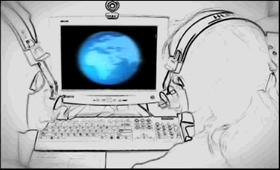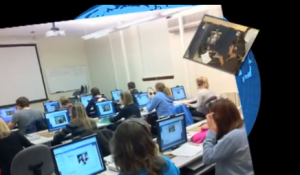Supporting the Path to Proficiency- Virtual Dual Immersion
Collaborating Authors: Carolina Marturet de Paris, Colleen Coffey and Oscar Mora, Project Coordination Team AUSJAL University Consortium. AJCU- AUSJAL University Project Coordinators: Rebecca Sanchez; Cindy Bravo; Olaf Bohlke; Omega Burckhardt; Diane Ceo Difrancesco; Aidee Horton; Jessica Martin; Maria Mena; Edison Santacruz; Holly Schneider and Fernando Baron.
 For language learners, distance has long been a challenge: although immersion in the language and culture of another country is traditionally the best approach for language acquisition, few students have the opportunity to travel abroad. Today, however, the globalizing effects of the internet and web conferencing technology are promising to change this paradigm, as more people make contact–and forge relationships–through virtual interaction.
For language learners, distance has long been a challenge: although immersion in the language and culture of another country is traditionally the best approach for language acquisition, few students have the opportunity to travel abroad. Today, however, the globalizing effects of the internet and web conferencing technology are promising to change this paradigm, as more people make contact–and forge relationships–through virtual interaction.
One prime example is the Dual Immersion Project, a collaborative effort between the Association of Jesuit Colleges and Universities (AJCU) in the United States and the American Asociación de Universidades Confiadas a la Compañía de Jesús en América Latina (AUSJAL), a Latin American Jesuit organization. Leveraging web conferencing and the networking potential of the Jesuit community, the program pairs Jesuit college students learning English with those learning Spanish, and it now counts 22 participating Jesuit institutions from the United States and Latin America. The project has also led to dual immersion partnerships with non-Jesuit schools from around the world, and, at some institutions, dual immersion in languages other than English and Spanish.
Since its inception six years ago, the program has seen explosive growth, largely because virtual dual immersion has proven to be a different–and even transformative–experience. As students interact and learn more about each other’s lives, their desire to communicate and connect becomes the driving motivation for language acquisition, and the discovery of both commonalities and differences leads naturally to increased cultural awareness and competency.
A virtual immersion session typically lasts 50 minutes to an hour, with students spending equal time conversing in each other’s native language. Topics vary by institution and instructor, but students often discuss history, politics, the environment, and university life, as well as favorite pastimes and local traditions. The level of structure varies, too. Some students engage in scripted intentional conversations, while others create their own roadmaps to use as jumping-off points. Session settings also follow several different models: “desktop to desktop” in the classroom; a mix of in-class and language lab; and the autonomous model, in which students interact entirely outside of class. In addition, many schools hold virtual cultural events, which are large webinars with a cultural focus to involve multiple communities of people. The events are typically led by expert professors or administrators from the hosting institution, and may also feature accomplished professionals from that institution’s country. Topics for past events have included free trade, international social networking and e-marketing, telecollaboration, public health, sea turtle migration, and Mexican film.
With this approach to learning, the student role changes. Students must take the initiative as they negotiate language and meaning in a second language–and also help their session partners do the same. As an instructor points out, “dual immersion demands greater responsibility from students, because they must also be teachers.”
Many students report that learning language and culture collaboratively among peers has been a liberating experience. “I feel less nervous because I know my partner is having just as much trouble as I am,” says one student, “and I know they want to help.” For another student, the dual immersion approach has meant “not dwelling on making mistakes while speaking the language, because the listener can usually understand what you’re saying and will correct you.” The dual immersion experience has also helped broaden students’ larger perspectives. “I am more aware of language learning and realize it is a lifelong process that is never complete,” observes one student. Another student has come to believe that “learning about other beliefs and cultures could be the key to more productive relations” between people and countries.

With virtual dual immersion, the role of the teacher also changes. Traditionally, language teachers prepare a class for all content input; they gapify content in paired activities and facilitate all student pair groupings, as well as activity progression during class time. Dual immersion, however, demands a collaborative partnership, and the focus is on training students for communication strategies so they’ll be successful in conversations with native speakers. During a session, the teacher is connecting students, monitoring conversations for feedback and follow-up, offering technical assistance and standing by to provide support, however it’s needed. With immersion language learning, accents, expressions, pronunciation and rate of speech become essential components of survival, as these factors will generate the fastest breakdown in comprehension and conversation.
Given the number of schools, cultures, and time zones involved, it shouldn’t come as a surprise that the Dual Immersion Project has encountered some hurdles along the way. Faculty partnerships have led to numerous clashes of culture and expectation. Initially, many instructors were resistant to the notion of virtual interaction, believing it would take time away from “real” language instruction. Faculty were intimidated by new technology and fearful of technical glitches, and more than a few adopted a “NIH” (not invented here) mentality: the program was not their own, and they saw it as demanding a lot of work with no clear benefit to their career. In some cases, faculty were also unsure that peer mentoring would be effective, and they often had trouble believing that anything was “actually happening” during sessions since they were not in the center of action.
But despite initial doubt among faculty at many institutions, there have always been one or two instructors willing to pioneer a new approach and several more to follow. As the program has grown, buy-in has been achieved and many instructors have embraced virtual dual immersion, not only for its effect on student motivation and language proficiency, but for its impact on their own perspectives. In fact, especially for non-native Spanish instructors in the United States, participating in the program has been its own learning experience: like their students, instructors must navigate the different cultures and variations of Spanish of Latin America.
Since the program began, faculty and students alike have discovered that preparation and guidance are crucial, and so is building community. Partner institutions now share curriculum guidelines, as well as agreed-upon training components for sessions. Perhaps most importantly, all participants now follow an established protocol, developed in response to lessons learned:
• All partner institutions recognize they are members of a larger learning community and agree to the essential terms of community engagement. They acknowledge the equality of each partner institution and work to achieve the objectives of their partner institution, not just their own. Staff at partner institutions agree to respond to email correspondence within 48 hours.
• At the start of each semester, faculty at partner institutions meet to fill out pre-session forms for expectations and learning outcomes, as well as for student commitment to punctuality, attendance, and learning partnerships. Students must sign contracts outlining their responsibilities and commitments as learning partners. This system helps participants to avoid miscommunications and misunderstandings, and it emphasizes the importance of sharing the same expectations and supporting one another.
• Before each session, staff at partner institutions perform tests to confirm connectivity, and faculty meet to discuss session logistics. After each term, faculty meet again and review the sessions by sending in post session reports. They also send and discuss post-session student surveys. This strategy is based on the idea of prevention instead of reaction. All technical issues should be resolved ahead of time on both ends, so one community is not waiting for the other when a session begins. For faculty and other staff, the goal should be developing more effective sessions. All partners learn over time, and they become better synchronized with practice and experience.
Ultimately, the most important resources for the program are not technical, but instead the age-old principles of commitment and accountability. As one instructor explains to her students, “language is a social contract–our word is our bond.”
PARTICIPATING UNIVERSITIES:
|
AUSJAL |
AJCU |
|
Universidad Javeriana- Bogotá |
Marquette University |
|
Universidad Javeriana-Cali |
Boston College |
|
Universiad Rafael Landivar |
Creighton University |
|
Pontificia Universidad Católica Ecuador |
Holy Cross University |
|
Iberoamericana-León |
University of San Francisco |
|
Iberoamericana-Torreón |
Loyola Maryland University |
|
Iberoamericana-Puebla |
Xavier University |
|
Instituto Tecnológico de Estudios Superiores (ITESO) |
Canisius College |
|
Universidad Católica Andrés Bello |
Santa Clara University |
|
Universidad Centro Americana (Nicaragua) |
John Carroll University |
|
Universidad Católica del Uruguay |
Scranton University |
REFERENCES
Montes, Jairo A. y Solanlly Ochoa A. Apropiación de las tecnologías de la información y comunicación en cursos universitarios. Revista Acta Colombiana de Psicología V. 0 N. 2. Bogotá, 2006.
O’Dowd, Robert. An introduction for Foreign Language Teaching. Edited by Michael Byram and Alison Phipps. Online Intercultural Exchange, 2007.
O’Dowd, Robert. “Intercultural Communicative competence through telecollaboration.” The Routledge Handbook of Language and Intercultural Communication, edited by Jane Jackson, Routledge, 2011.
AUSJAL AJCU. Virtual Dual Immersion Participants. Feedback Tables collected from each institution with professor and coordinator feedback. 2012.
Scolari, Carlos. Hipermediaciones. Gedisa Barcelona, 2009.
Wenger, Etienne. “Communities of Practice.” Last modified June, 2006. http://www.ewenger.com/theory/
Wheatley, Magaret and Deborah Frieze. Using Emergence to Take Social Innovation to Scale. Publication of The Berkana Institute, 2008. www.berkana.org
